Sprained Ankle: A Physiotherapists Comprehensive Guide
A sprained ankle is one of the most commonly occurring injuries. If treated correctly with physio you should recover fully and not be at a higher risk of sustaining the same injury again. However, if you simply rest the ankle until the pain has eased and then return to activities/sports research shows that you are more susceptible to injuring the ankle again. This is due to long standing instability of the ankle, often because they have not rehabbed it correctly with the appropriate physiotherapy.
The Injury
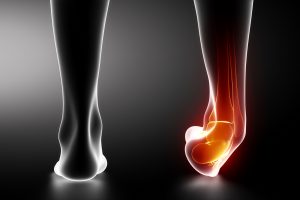 A sprained ankle is typically what we call an inversion strain. This is where you ‘go over’ on your ankle. There are three ligaments that support the outside of your ankle and can be injured during a sprain. The most common is the anterior talofibular ligament which is found just in front of the ankle bone (fibula) on the outside of your ankle. If the injury is slightly more severe you may also strain the calcaneofibular ligament which you will find directly below your ankle bone. Typically, you can tell which ligaments are injured by pressing on each one with your fingertip. So feel the area in front of the tip of the ankle bone and also below it to see if one or two of the ligaments are possibly injured. The third ligament is the posterior talofibular ligament and is much less likely to be injured. This can be found just behind the ankle bone.
A sprained ankle is typically what we call an inversion strain. This is where you ‘go over’ on your ankle. There are three ligaments that support the outside of your ankle and can be injured during a sprain. The most common is the anterior talofibular ligament which is found just in front of the ankle bone (fibula) on the outside of your ankle. If the injury is slightly more severe you may also strain the calcaneofibular ligament which you will find directly below your ankle bone. Typically, you can tell which ligaments are injured by pressing on each one with your fingertip. So feel the area in front of the tip of the ankle bone and also below it to see if one or two of the ligaments are possibly injured. The third ligament is the posterior talofibular ligament and is much less likely to be injured. This can be found just behind the ankle bone.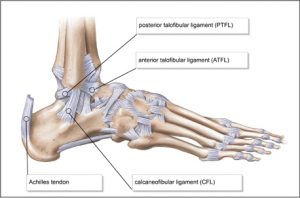
The other factor which will impact on the severity of the injury is the grade of the ligament strain. This is on a range from a grade 1 to 3 depending on the amount of damage or the number of ligaments that are damaged. A grade 1 sprain is defined as mild damage to a ligament or ligaments without instability of the affected joint. A grade 2 sprain is considered a partial tear to the ligament, in which it is stretched to the point that it becomes loose. A grade 3 sprain is a complete tear of a ligament, causing instability in the affected joint.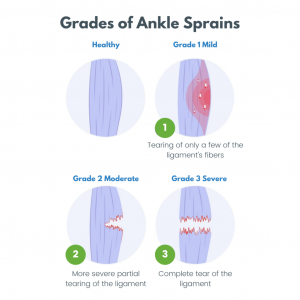
Recovery
You will have swelling immediately following the injury so the early stage of treatment follows the PRICE regime. Protection, Rest, Ice, Compression and Elevation. Protection is best from an ankle brace rather than a simple tubigrip. Rest prevents further bleeding and irritation of the ligament. Ice can be applied for 20 mins every 2 hours. Compression will also help to limit swelling as will elevation of the leg, although research shows that to be truly effective elevation needs to be at 60 degrees above heart level. So lie on your back with the leg well elevated. We have Therabody Air Compression Boots which are extremely effective in reducing swelling. It is now widely thought that it is actually best not to take anti inflammatories straight after the injury as there are important chemicals needed for the healing process found in the inflammation. If your ankle is still very swollen 3-4 days after the injury then this may be the time to start to use them, but always check with your GP regarding medication.
It is important to maintain the mobility of your ankle. Recovery is shown to be better if you keep your ankle moving as pain allows. Some discomfort is okay as long as it is not too sore. We use manual therapy techniques to mobilise the ankle if there is any restriction in it’s movement. As pain settles, perhaps around the 1-2 week mark, we would progress to strengthening exercises for the ankle and working on the balance mechanism that is so important for ankle stability. We would also ensure you rehab the leg as a whole, involving compound movements to challenge the leg and ankle at the same time.
Once pain has resolved with day to day activities and if the ankle is showing good stability you would progress to impact exercises such as hopping and other forms of plyometric exercises. If these do not cause pain or swelling then it may be the right time to start a graded return to running. Increasing speed, changing terrain and introducing changes of direction if the ankle is feeling okay. Look out for any pain or swelling after exercise or the following morning. This is a sign that you may have to take a step back in your rehab. If it is feeling okay it is at this stage that you could return to sports although you may still choose to wear a support for the first few sessions. Try not to rely on this for too long though as it is better to expose the ankle to the stress and strain of training as this strengthens it further and is a factor in preventing recurrence. 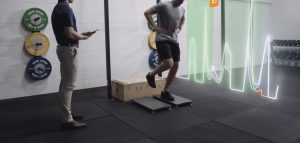 For an evidence based decision if the ankle is ready to return to sport we can test you on our Force Plates, performing strength/balance/jumping/hopping tests which highlight any deficiency that may still be present compared to the other side. If you test well then it is a green light to return to sport. This is crucial as research shows that the most common time to be injured is returning to sport/activity following a previous injury. Although pain has resolved, many people are simply not ready, the force plates are perfect to highlight if this is the case.
For an evidence based decision if the ankle is ready to return to sport we can test you on our Force Plates, performing strength/balance/jumping/hopping tests which highlight any deficiency that may still be present compared to the other side. If you test well then it is a green light to return to sport. This is crucial as research shows that the most common time to be injured is returning to sport/activity following a previous injury. Although pain has resolved, many people are simply not ready, the force plates are perfect to highlight if this is the case.
Soft tissue healing for a ligament strain typically takes 3-6 weeks depending on the severity of the strain. A more severe strain will take much longer and it may be several months before a person can return to training/sports.
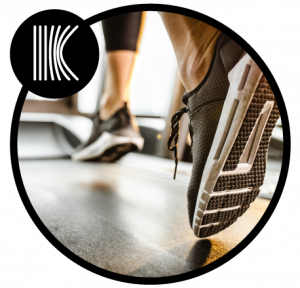
This is a guide for general information only. Injuries should be assessed by a qualified specialist such as a physiotherapist or doctor. There are complicating factors that may need to be assessed and addressed. The progression through the various stages of rehab will be guided by a physio and we also perform hands on treatment for your calf, ankle joint and ligaments.










